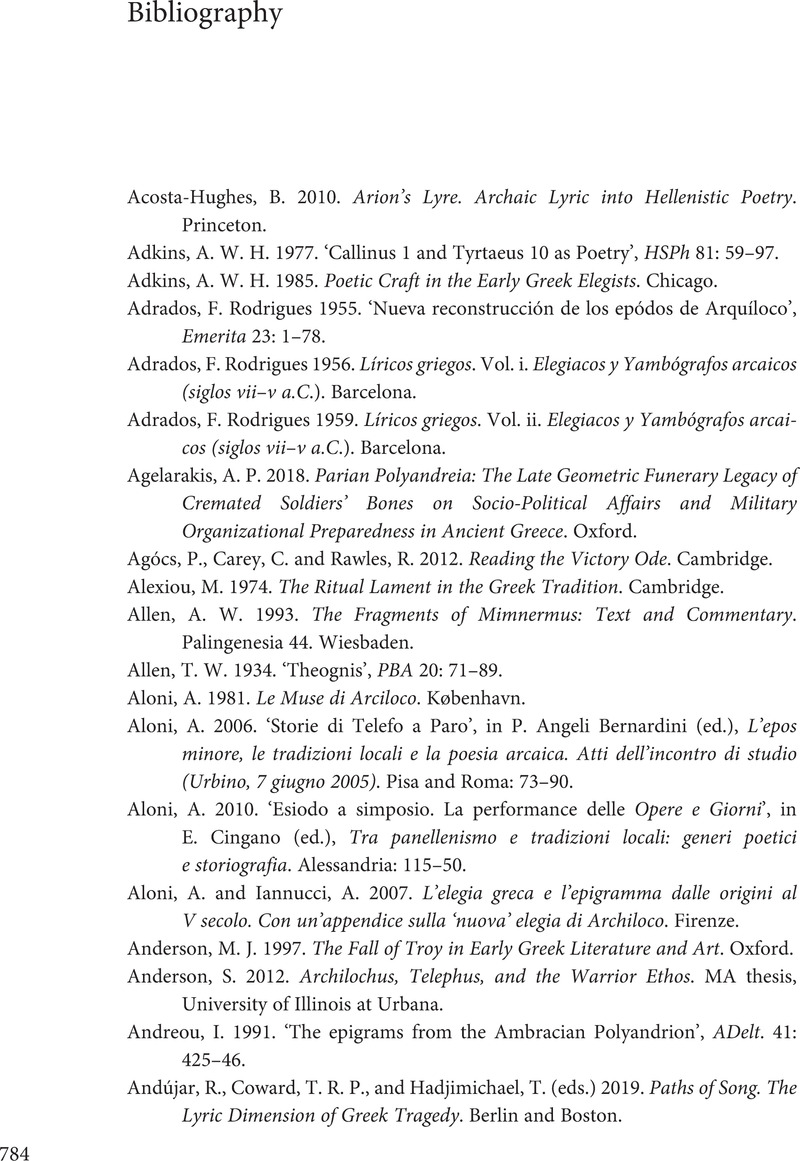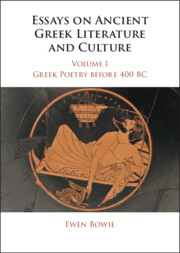Book contents
- Essays on Ancient Greek Literature and Culture
- Essays on Ancient Greek Literature and Culture
- Copyright page
- Contents
- Illustration and Tables
- Places of Original Publication
- Preface
- Editions and Abbreviations
- Introduction to Volume 1: Greek Poetry before 400 BC
- 1 Early Greek Elegy, Symposium and Public Festival (1986)
- 2 One That Got Away: Archilochus frr. 188–92 and Horace Odes 1.4 and 5 (1987)
- 3 Miles ludens? The Problem of Martial Exhortation in Early Greek Elegy ()
- 4 Lies, Fiction and Slander in Early Greek Poetry (1993)
- 5 Greek Table-Talk before Plato (1993)
- 6 The Theognidea: a Step towards a Collection of Fragments? (1997)
- 7 Early Greek Iambic Poetry: the Importance of Narrative (2001)
- 8 Ancestors of Historiography in Early Greek Elegiac and Iambic Poetry? ()
- 9 Sympotic Praise (2002)
- 10 Early Expatriates: Displacement and Exile in Archaic Poetry ()
- 11 From Archaic Elegy to Hellenistic Sympotic Epigram? (2007)
- 12 Sex and Politics in Archilochus’ Poetry (2008)
- 13 Wandering Poets, Archaic Style (2009)
- 14 Epigram as Narration (2010)
- 15 Historical Narrative in Archaic and Early Classical Greek Elegy (2010)
- 16 Stobaeus and Early Greek Melic, Elegiac and Iambic Poetry (2010)
- 17 Marathon in Fifth-Century Epigram (2010)
- 18 The Trojan War in Early Greek Melic, Iambic and Elegiac Poetry (2010)
- 19 Performing and Re-performing Helen:Stesichorus’ Palinode (2010)
- 20 Simonides of Eretria (redivivus?) (2010)
- 21 Alcman’s First Partheneion and the Song the Sirens sang (2011)
- 22 An Early Chapter in the History of the Theognidea (2012)
- 23 Stesichorus and Ibycus: Plain Tales from the Western Front (2012)
- 24 Epinicians and ‘Patrons’ (2012)
- 25 Unnatural Selection: Expurgation of Greek Melic, Elegiac and Iambic Poetry (2012)
- 26 Marathon, the 1500 Days after: Culture and Politics (2013)
- 27 The Sympotic Tease (2013)
- 28 Rediscovering Sacadas (2014)
- 29 Stesichorus’ Geryoneis and Greeks in the West (2014)
- 30 Stesichorus at Athens (2015)
- 31 Cultic Contexts for Elegiac Performance? (2016)
- 32 Quo usque tandem? How long were Sympotic Songs? (2016)
- 33 How did Sappho’s Songs get into the Male Sympotic Repertoire? (2016)
- 34 The Performance Contexts of Trochaic Tetrameters Catalectic (2018)
- 35 Alcaeus’ stasiotica: Catullan and Horatian Readings (2019)
- 36 Reconfiguring Archilochus: How have Papyri and Inscriptions changed Perceptions of Archilochus’ Iambic and Elegiac Poetry? (2020)
- Bibliography
- Index Locorum
- Index of Greek Terms
- General Index
- References
Bibliography
Published online by Cambridge University Press: 11 December 2021
- Essays on Ancient Greek Literature and Culture
- Essays on Ancient Greek Literature and Culture
- Copyright page
- Contents
- Illustration and Tables
- Places of Original Publication
- Preface
- Editions and Abbreviations
- Introduction to Volume 1: Greek Poetry before 400 BC
- 1 Early Greek Elegy, Symposium and Public Festival (1986)
- 2 One That Got Away: Archilochus frr. 188–92 and Horace Odes 1.4 and 5 (1987)
- 3 Miles ludens? The Problem of Martial Exhortation in Early Greek Elegy ()
- 4 Lies, Fiction and Slander in Early Greek Poetry (1993)
- 5 Greek Table-Talk before Plato (1993)
- 6 The Theognidea: a Step towards a Collection of Fragments? (1997)
- 7 Early Greek Iambic Poetry: the Importance of Narrative (2001)
- 8 Ancestors of Historiography in Early Greek Elegiac and Iambic Poetry? ()
- 9 Sympotic Praise (2002)
- 10 Early Expatriates: Displacement and Exile in Archaic Poetry ()
- 11 From Archaic Elegy to Hellenistic Sympotic Epigram? (2007)
- 12 Sex and Politics in Archilochus’ Poetry (2008)
- 13 Wandering Poets, Archaic Style (2009)
- 14 Epigram as Narration (2010)
- 15 Historical Narrative in Archaic and Early Classical Greek Elegy (2010)
- 16 Stobaeus and Early Greek Melic, Elegiac and Iambic Poetry (2010)
- 17 Marathon in Fifth-Century Epigram (2010)
- 18 The Trojan War in Early Greek Melic, Iambic and Elegiac Poetry (2010)
- 19 Performing and Re-performing Helen:Stesichorus’ Palinode (2010)
- 20 Simonides of Eretria (redivivus?) (2010)
- 21 Alcman’s First Partheneion and the Song the Sirens sang (2011)
- 22 An Early Chapter in the History of the Theognidea (2012)
- 23 Stesichorus and Ibycus: Plain Tales from the Western Front (2012)
- 24 Epinicians and ‘Patrons’ (2012)
- 25 Unnatural Selection: Expurgation of Greek Melic, Elegiac and Iambic Poetry (2012)
- 26 Marathon, the 1500 Days after: Culture and Politics (2013)
- 27 The Sympotic Tease (2013)
- 28 Rediscovering Sacadas (2014)
- 29 Stesichorus’ Geryoneis and Greeks in the West (2014)
- 30 Stesichorus at Athens (2015)
- 31 Cultic Contexts for Elegiac Performance? (2016)
- 32 Quo usque tandem? How long were Sympotic Songs? (2016)
- 33 How did Sappho’s Songs get into the Male Sympotic Repertoire? (2016)
- 34 The Performance Contexts of Trochaic Tetrameters Catalectic (2018)
- 35 Alcaeus’ stasiotica: Catullan and Horatian Readings (2019)
- 36 Reconfiguring Archilochus: How have Papyri and Inscriptions changed Perceptions of Archilochus’ Iambic and Elegiac Poetry? (2020)
- Bibliography
- Index Locorum
- Index of Greek Terms
- General Index
- References
Summary

- Type
- Chapter
- Information
- Essays on Ancient Greek Literature and Culture , pp. 784 - 823Publisher: Cambridge University PressPrint publication year: 2021



